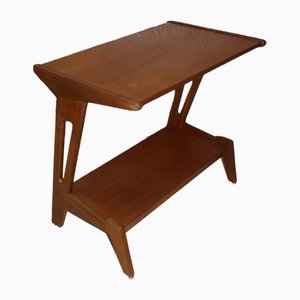
Dutch furniture manufacturer WéBé was founded in 1938 in Benden-Leeuwen (near Tiel). Originally called Walraven and Bevers after its two founders, the company’s name was later shortened to the abbreviated WéBé.
The company had a slow start, but in the 1950s and ’60s it gained major recognition and expanded to become one of the largest furniture producers in the Netherlands. This success had a lot to do with Dutch designer Louis van Teeffelen (1921-1972), who became Wébé’s head designer in 1955. Van Teeffelen introduced a classic midcentury Scandinavian aesthetic and a number of popular designs in a similar style to the work of his contemporary, Poul Cadovius (1911-2011). Casegoods and tables with anthropomorphic, “smiling” handles along with sculptural structures became van Teeffelen’s signature. His work for Wébé includes the Cow Horn Chair (1950s); Scissor Chair (1950s); Pelican Armchair (1960s); Easy Chair (1960s); an array of teak dining tables, coffee tables, sideboards, and desks; and various modular wall systems that feature teak shelves and cabinets.
Van Teeffelen, who left the company in 1967, turned out to be the only significant and well-received designer in WéBé’s history. In the 1970s, the company hit rough times, not only suffering van Teeffelen’s loss but also meeting with increased competition from new low-cost, mass-produced furniture companies. In the 1990s, Wébé ceased manufacturing all together and closed its doors for good. Although the company is no longer in business, van Teeffelen’s designs are considered excellent examples of the midcentury modern movement and are highly sought-after by collectors today.

